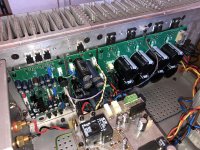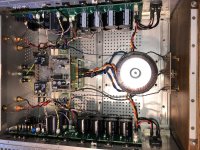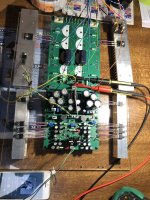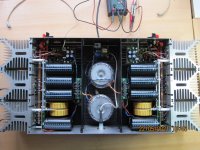Hello.
This is my modified A75 amp - maybe just an A40 from Nelson Pass. It worked the first time it was turned on and has been working great for 2 years.
The chassis is still not made, but it still sounds good.
This is my modified A75 amp - maybe just an A40 from Nelson Pass. It worked the first time it was turned on and has been working great for 2 years.
The chassis is still not made, but it still sounds good.
Attachments
-
A75_vstup.pdf94.4 KB · Views: 340
-
 IMG_4217.JPG659.4 KB · Views: 502
IMG_4217.JPG659.4 KB · Views: 502 -
 IMG_4214.JPG649.3 KB · Views: 478
IMG_4214.JPG649.3 KB · Views: 478 -
 IMG_4208.JPG596.6 KB · Views: 425
IMG_4208.JPG596.6 KB · Views: 425 -
 IMG_4201.JPG535.8 KB · Views: 465
IMG_4201.JPG535.8 KB · Views: 465 -
 IMG_2334.jpg676.2 KB · Views: 473
IMG_2334.jpg676.2 KB · Views: 473 -
Ochrany.pdf77.2 KB · Views: 187
-
Stabilizator2.pdf27.9 KB · Views: 169
-
A75_vystup.pdf44.2 KB · Views: 211
Impressive work, especially the protection circuits and µC. Well designed and a good layout, i wish i could say this about my A75.
A low power A75, although the heatsinks look like they can take a whole lot more. Anyway, the A75 is a great sounding amp.
Your regulated +/-70V power supply for the frontend is a nice addition, i thought about building one for my A75, but in 15 years i only changed the voltage doubler caps once as a precaution, and they still measured well.
I presume D3 and D4 are some kind of protection, is there any documentation about them or did you put them yourself ? I found only two documents about changes from the original A75 article. If you have other documents or information it would be great if you could share them.
Is there a reason for keeping the 1 ohm source resistors ? As you have double device current, you could have reduced the source resistors to 0,56 ohms for same amount of degeneration. It would be interesting to know about sound differences.
Also, can you show me the connection of J5 DC_Out (vstup), i could not find.
Greetings,
Norbert
A low power A75, although the heatsinks look like they can take a whole lot more. Anyway, the A75 is a great sounding amp.
Your regulated +/-70V power supply for the frontend is a nice addition, i thought about building one for my A75, but in 15 years i only changed the voltage doubler caps once as a precaution, and they still measured well.
I presume D3 and D4 are some kind of protection, is there any documentation about them or did you put them yourself ? I found only two documents about changes from the original A75 article. If you have other documents or information it would be great if you could share them.
Is there a reason for keeping the 1 ohm source resistors ? As you have double device current, you could have reduced the source resistors to 0,56 ohms for same amount of degeneration. It would be interesting to know about sound differences.
Also, can you show me the connection of J5 DC_Out (vstup), i could not find.
Greetings,
Norbert
Attachments
I used all transistors IRF510 and IRF9510. I tried different types, but the 510s proved to be very good.
I didn't even use diodes D3 and D4. I've seen it plugged in for stability somewhere. But this amplifier worked right away on the right connection without hesitation.
I did not deal with 1 ohm resistors at all. I don't think that reducing their values would audibly change the sound. But it might be worth testing. I do not know.
J5 is a switch that connects and disconnects the DC Servo. I use a DC servo. Of course, only after the correct setting of the amplifier - RV1 and RV2.
If you want some background from this amplifier PCB - gerber, program with protection or soft start - there is no problem.
I am very happy to share what I know and what I have.
I didn't even use diodes D3 and D4. I've seen it plugged in for stability somewhere. But this amplifier worked right away on the right connection without hesitation.
I did not deal with 1 ohm resistors at all. I don't think that reducing their values would audibly change the sound. But it might be worth testing. I do not know.
J5 is a switch that connects and disconnects the DC Servo. I use a DC servo. Of course, only after the correct setting of the amplifier - RV1 and RV2.
If you want some background from this amplifier PCB - gerber, program with protection or soft start - there is no problem.
I am very happy to share what I know and what I have.
Attachments
Thank you for your offer. My A75 is nearly identical to the original design, biggest difference (some would say mistake) is use of TO-220 IRF9630/630, and i have no additional protection at all. There were some output device failures (thermal ageing), but not catastrophic and the amp still worked well with app. 2V DC on one output, only the heatsink got really hot.
The DC-Servo is interesting. My amp goes to ~200mV offset shortly after start and settles down to 50mV within 10 minutes. Did you adapt the integrator to the time constant of the heatsinks ?
I think that the source resistors will affect the output impedance/damping factor of the amp. How much of a difference that makes i dont know, but i put 0,82 ohms with 12 MOSFETs (130mA bias) in parallel and I can say that bass is impressive (also physically), but this will depend on speakers too.
Your schematic shows C7/C15, did you put them in ? Also, did you try different settings/values for R81 and R21/22 ?
The DC-Servo is interesting. My amp goes to ~200mV offset shortly after start and settles down to 50mV within 10 minutes. Did you adapt the integrator to the time constant of the heatsinks ?
I think that the source resistors will affect the output impedance/damping factor of the amp. How much of a difference that makes i dont know, but i put 0,82 ohms with 12 MOSFETs (130mA bias) in parallel and I can say that bass is impressive (also physically), but this will depend on speakers too.
Your schematic shows C7/C15, did you put them in ? Also, did you try different settings/values for R81 and R21/22 ?
Attachments
Thanks for the advice and inspiration. I'll be thinking about this if I'm modifying my amp.If you can, use the Harris versions of IRF9510 to avoid greater thd on upper mid and top end.

Using TO-220 is not a problem. I would like to see someone who can tell them apart from other transistors by listening.Thank you for your offer. My A75 is nearly identical to the original design, biggest difference (some would say mistake) is use of TO-220 IRF9630/630, and i have no additional protection at all. There were some output device failures (thermal ageing), but not catastrophic and the amp still worked well with app. 2V DC on one output, only the heatsink got really hot.
The DC-Servo is interesting. My amp goes to ~200mV offset shortly after start and settles down to 50mV within 10 minutes. Did you adapt the integrator to the time constant of the heatsinks ?
I think that the source resistors will affect the output impedance/damping factor of the amp. How much of a difference that makes i dont know, but i put 0,82 ohms with 12 MOSFETs (130mA bias) in parallel and I can say that bass is impressive (also physically), but this will depend on speakers too.
Your schematic shows C7/C15, did you put them in ? Also, did you try different settings/values for R81 and R21/22 ?
I've read about various experts getting burned by blind listening.
So if you like the sound of your amp, all is well. As I already wrote - it's just about the feeling when listening to your favorite music.
Someone will also enjoy it with MP3 on the PC speaker.
I used a DC-servo from my previous amp. I didn't change anything and it works fine.
Without a DC servo, I managed to set the output offset below 10 mV on both channels.
I also have a temperature sensor on the heatsink - DS18B20. Everything is checked on the protection board.
Source resistors - I cannot assess the effect of output impedance on sound quality. What is the best output impedance?
I agree that low impedance is good.
And I also agree that sound and bass will depend a lot on the speaker. And not only from that. What sound source is used? Stream? CD player? Turntable?
I used C7/C15. R81 = 0R and R21/22 = 100R. I did not try to change them or test their value in any way.
I still think Nelson Pass and Norm Thagard did a great job designing these amps. Big thanks.
My device is by no means perfect, nor will it ever be. Well, for the price and effort, it's a very good amplifier.
I also have a B1 preamp with a Korg Nutube triode from Nelson Pass. Great.
And for the third time, I also made a Whammy headphone amplifier. Of course, I have slightly modified each of these devices. But only a little bit.
All these devices are great for me. I simply enjoy my favorite music.
- Home
- Amplifiers
- Pass Labs
- Nelson Pass A75 (A40)
